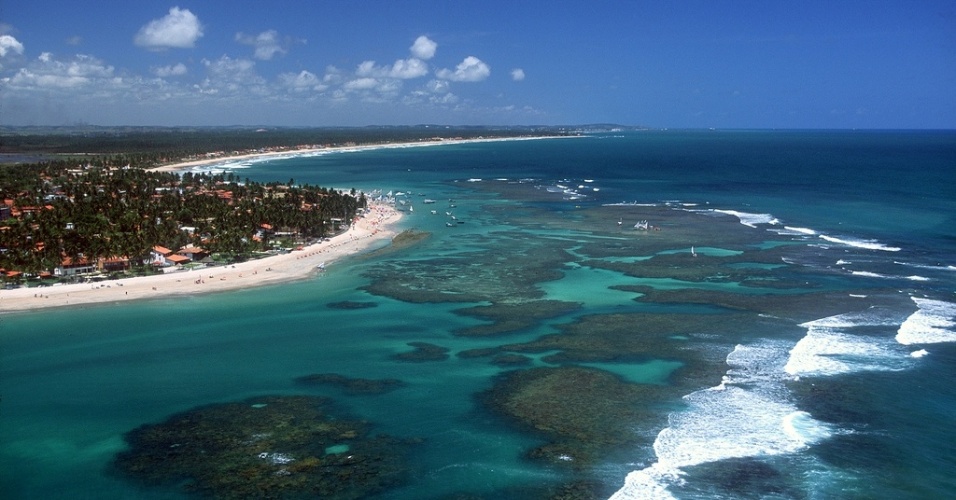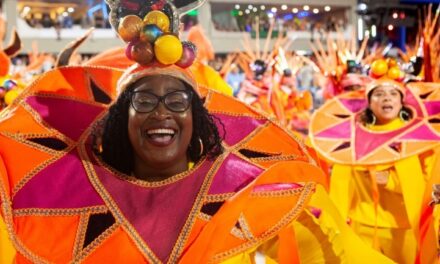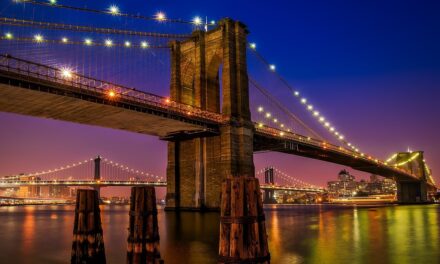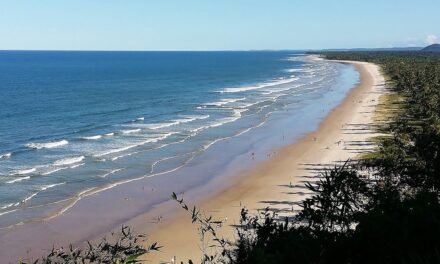By Lindenberg Junior / Translation: Magali da Silva
I left Recife by car southbound towards the city of Cabo de Santo Agostinho on a beautiful Saturday afternoon. My main intention was to visit an old friend that I have not seen for over 20 years and enjoy a relaxing day in nature. I drove only 40 minutes and arrived at my destination: the “Orchid Posada” in the small fishing village of Suape beach.
The region is an historic site represented by old devices for sugar cane, colonial churches and Forts – the scene of many battles between the Portuguese and the Dutch in the seventeenth century, some of which are already in ruins.
The importance of tourism in this region has increased by a beautiful coast, mangrove reserve and the “still alive” gorgeous Atlantic Forest. So here I began a weekend escape in search for direct contact with nature and good times. Body board, kayak, ecological walks, meditation, fresh coconut water, a lot of seafood, and also a therapeutic morning in a “natural clay pool”. Fernando de Paiva Melo, or simply “Murrinha”, known among the Brazilian Northeastern surfing world and a very popular guy in the Southern zone of Recife during the years 1980 and 1990, greeted me with a smile on his face, and green tea on the table in his small, but cozy posada. From the enormous balcony I could see the calm sea, a small island, many coconut trees and even a river.
Murrinha, that considers himself an “exiled urban” in search for surfing and diving, arrived there in 1983, and today takes part of the Cabo de Santo Agostinho city council of tourism. We talk about surfing, spirituality, music, nature and history of Brazil. Fernando opens the book “Captain of Brazil” (Eduardo Bueno, Terra Brasil collection) and told me about the innumerable shipwrecks that occurred at the time of the Dutch colonization. After a long conversation and the night approaching, Murrinha, inspired, went to the kitchen and cooked a delicious dinner. The menu: colorful salad, Brazilian seafood risoto and pumpkin “quibebe”.
When I started to find out about the project “Banho da Lama” (Mud Bath) and the project “Sitio Ecologico 2 Lagoas” (Ecological Farm 2 Lagoon), both close to the posada in the neighboring beach of Itapuama, at this very moment, it occurred to me to convey my experience in an article for Soul Brasil magazine. It was after 11pm, when I decided to lie down in a hammock in the living room and quickly with the silence, sleep.
At 5:30am I woke up with a rooster calling and at 6:30 I got up to go for a walk on the beach and some photos. When I returned at 7:30, I met with my host and set the table for the breakfast. Coconut tapioca and a super natural energy drink smoothie with guaraná syrup, peanut and chestnut powder, flax seed, oyster powder, celery and apple pieces were all on the menu. Uaauuu! We start the day firm and strong.
We then went to the Paradise Beach between the beach of Suape and the lighthouse of Cabo de Santo Agostinho (the second most Easter point of Brazil). This beach is dense vegetation areas hidden by a thick wall of rocks, where trees and coconut palms grow and lean over on the sea, natural swimming pools of rocks, dense vegetation areas and a panoramic sight of Suape and the Islands of Tatuoca and Cocáia. Today it is considered one of the most exotic places in Brazil. There we found three rustic little bars with options for fresh seafood, cold Brazilian beer and unbelievable sight to admire.
 We continued along the Golden Coast 2 route to stop in Itapuama, where we had some fun on the beach body-boarding. It was about 1pm when I decided that it was time to follow for the Sitio Ecologico 2 Lagoas, just 2 miles from the beach. To my surprise, the proprietor Fred Negão also was an old friend.
We continued along the Golden Coast 2 route to stop in Itapuama, where we had some fun on the beach body-boarding. It was about 1pm when I decided that it was time to follow for the Sitio Ecologico 2 Lagoas, just 2 miles from the beach. To my surprise, the proprietor Fred Negão also was an old friend.
The “Sitio” is an opened ecological reserve for visitation where the exuberant scenario is an invitation to live deeply a magnificent experience with the nature. It offers strolls of boat and kayak, fishing, hammocks in the rest area, and ecological tracks – one with access to the top of Murici Mountain where you can see the sea and the Atlantic forest, perfect for meditation and yoga. A place to connect ourselves with nature and explore its colors, sounds, smell and its many animal species.
Fred told me that in this part of the Atlantic forest, we can find trees as angelim (used for manufacture rustic furniture), the visgueiro (highest of the Atlantic forest), imbiriba (used to manufacture the berimbau, capoeira main instrument), and praiba (used to manufacture the rebeca, an artisan violin). The place is frequently visited by biologists, naturists, therapists and yogis. Fred also mentioned a problem found recently in this part of the Atlantic forest: the proliferation and respective plague of termites and ants in consequence of the missing its predators, the tamanduás.
To finish the day we visited the “projeto banho de lama” (mud bath project). It is another ecological area, but with a particular attractive: the “natural clay pool”. We saw people in the “pool” as well other already out with the bodies covered of clay. The manager, the local native Robert, explains that people go into the pool of clay, stay for a while, and leave the pool with clay remains on their body for about 30 minutes. After that, they take a walk on a path of less than 1 mile in direction to the sea, where they swim in the ocean and remove the clay. Used by a variety of different cultures since the antiquity, as the case of Vietnamese’s and the Amazon Indians, the clay today has proven its scientific effectiveness in the capacity of absorption of toxins of the skin, revitalization of the fabrics, and even further, the activation of the sanguineous circulation.
Beaches and Other Attractions Calhetas is a small beach surrounded by coconut palms and vestiges of Atlantic forest. It is considered by many folks as one of 10 prettier beaches in Brazil. In the past, it served as safe port for the Portuguese and Dutch troops. It should be called the “Emerald of Pernambuco”. Here, with luck, you can stay in a unique posada (Arthur’s) of delightful sight.
Gaibu, served as slave port in the past. The village is a small town with many small hotels and posadas, restaurants, markets and an option for the ones with an interest in enjoying the night life. It has natural swimming pools (in consequence of the reefs) when tide is low, and waves are big in high tide.
Itapuama, a variation of the word tupi-guarani Itapoã, means Pretty Rock, has rock formations of volcanic origin, and the open ocean excellent for surfing and fishing.
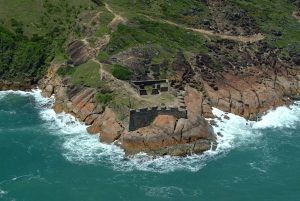 Cabo de Santo Agostinho is an older geographic accident of Brazil of several thousand years. Mentioned by some researchers and historians as being the accurate place of the discovery of Brazil for the Spanish navigator Vicente Yañez Pinzón months before the Portuguese
Cabo de Santo Agostinho is an older geographic accident of Brazil of several thousand years. Mentioned by some researchers and historians as being the accurate place of the discovery of Brazil for the Spanish navigator Vicente Yañez Pinzón months before the Portuguese
Suape is the starting point for boat strolls and diving. It had great importance when Brazil was being settled, where diverse battles between Portuguese, Dutch and Caetés Indians had been part of the daily routine of the area. In the extreme South of the beach, when the tide is low, can be seen the ruins of a Fort submerged in the waters. It is an excellent area for nautical sports. One of the most important industrial and port complexes of the country is there, and where you find the mega resort Blue Tree Park, one of the most expensive in Brazil. A good option for those wanting simplicity, we recommend the “Orchid Posada”.
Other Places of Interest The “Bom Jesus” sugar plantation, constructed in 1890 (milling period from October to March); the lighthouse “Pedra da Pimenta” in the district of Jussaral; the Island of the Frenchman; the Gurjaú waterfall and the Fens Biological Reserve.
In the cultural and popular manifestations, the Cabo de Santo Agostinho presents a diverse folk art where we can make special mention to the ceramic work. Amongst special events, interesting to see the “Festa das Lavadeiras” (Party of the Laundrywoman) at the beach of Paiva and Itapuama (May 1); and the religious theme party “Festa do Bom Jesus dos Passos” (February) and “Festa de Santo Agostinho” (August), both are commemorated in the historical Village of Nazaré.
* For airline tickets from the United States to Brazil or Latin America, custom travel packages, hotels and alternative stays, as well as Cruises from the United States, contact our travel agent and tour organizer, Magali DaSilva. Phone/WhatsApp 1(323) 428-1963 – email: magali_at_soubrasil.com

